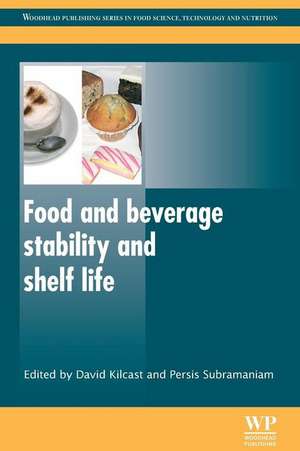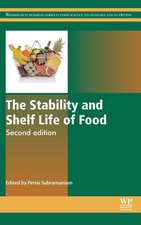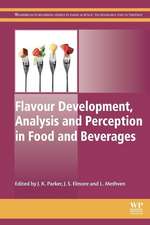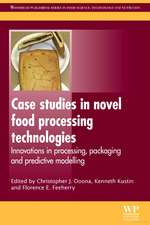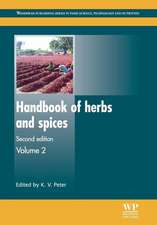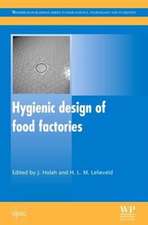Food and Beverage Stability and Shelf Life: Woodhead Publishing Series in Food Science, Technology and Nutrition
Editat de David Kilcast, Persis Subramaniamen Limba Engleză Paperback – 18 aug 2016
Part one describes important food and beverage quality deterioration processes, including microbiological spoilage and physical instability. Chapters in this section also investigate the effects of ingredients, processing and packaging on stability, among other factors. Part two describes methods for stability and shelf life assessment including food storage trials, accelerated testing and shelf life modelling. Part three reviews the stability and shelf life of a wide range of products, including beer, soft drinks, fruit, bread, oils, confectionery products, milk and seafood.
With its distinguished editors and international team of expert contributors, Food and beverage stability and shelf life is a valuable reference for professionals involved in quality assurance and product development and researchers focussing on food and beverage stability.
- A comprehensive guide to factors influencing stability, methods of stability and shelf life assessment and the stability and shelf life of major products
- Describes important food and beverage quality deterioration processes exploring microbiological spoilage and physical instability
- Investigate the effects of ingredients, processing and packaging on stability and documents methods for stability and shelf life assessment
Din seria Woodhead Publishing Series in Food Science, Technology and Nutrition
- 15%
 Preț: 391.19 lei
Preț: 391.19 lei - 24%
 Preț: 1333.02 lei
Preț: 1333.02 lei - 24%
 Preț: 1210.03 lei
Preț: 1210.03 lei - 24%
 Preț: 946.43 lei
Preț: 946.43 lei - 9%
 Preț: 1205.99 lei
Preț: 1205.99 lei - 24%
 Preț: 1189.10 lei
Preț: 1189.10 lei - 9%
 Preț: 984.09 lei
Preț: 984.09 lei - 9%
 Preț: 1006.66 lei
Preț: 1006.66 lei - 24%
 Preț: 960.56 lei
Preț: 960.56 lei - 23%
 Preț: 1419.50 lei
Preț: 1419.50 lei - 9%
 Preț: 1206.85 lei
Preț: 1206.85 lei - 9%
 Preț: 922.07 lei
Preț: 922.07 lei - 24%
 Preț: 1192.22 lei
Preț: 1192.22 lei - 9%
 Preț: 1215.75 lei
Preț: 1215.75 lei - 24%
 Preț: 1162.37 lei
Preț: 1162.37 lei - 9%
 Preț: 950.09 lei
Preț: 950.09 lei - 24%
 Preț: 1162.62 lei
Preț: 1162.62 lei - 24%
 Preț: 801.31 lei
Preț: 801.31 lei - 27%
 Preț: 379.84 lei
Preț: 379.84 lei - 29%
 Preț: 1336.07 lei
Preț: 1336.07 lei - 24%
 Preț: 798.74 lei
Preț: 798.74 lei - 9%
 Preț: 1018.93 lei
Preț: 1018.93 lei - 24%
 Preț: 1081.43 lei
Preț: 1081.43 lei - 24%
 Preț: 1185.22 lei
Preț: 1185.22 lei - 31%
 Preț: 922.77 lei
Preț: 922.77 lei - 24%
 Preț: 1131.77 lei
Preț: 1131.77 lei - 23%
 Preț: 1635.86 lei
Preț: 1635.86 lei - 9%
 Preț: 1277.62 lei
Preț: 1277.62 lei - 24%
 Preț: 1049.04 lei
Preț: 1049.04 lei - 24%
 Preț: 1134.60 lei
Preț: 1134.60 lei - 9%
 Preț: 1076.36 lei
Preț: 1076.36 lei - 24%
 Preț: 1158.21 lei
Preț: 1158.21 lei - 9%
 Preț: 1065.06 lei
Preț: 1065.06 lei - 9%
 Preț: 1067.39 lei
Preț: 1067.39 lei - 24%
 Preț: 812.03 lei
Preț: 812.03 lei - 9%
 Preț: 1203.13 lei
Preț: 1203.13 lei - 23%
 Preț: 1237.19 lei
Preț: 1237.19 lei - 24%
 Preț: 948.79 lei
Preț: 948.79 lei - 23%
 Preț: 1138.06 lei
Preț: 1138.06 lei - 9%
 Preț: 868.43 lei
Preț: 868.43 lei - 24%
 Preț: 871.98 lei
Preț: 871.98 lei - 20%
 Preț: 1272.59 lei
Preț: 1272.59 lei - 29%
 Preț: 1195.06 lei
Preț: 1195.06 lei - 9%
 Preț: 1045.58 lei
Preț: 1045.58 lei - 9%
 Preț: 1002.45 lei
Preț: 1002.45 lei - 9%
 Preț: 505.72 lei
Preț: 505.72 lei - 9%
 Preț: 1062.13 lei
Preț: 1062.13 lei - 24%
 Preț: 1306.94 lei
Preț: 1306.94 lei
Preț: 1226.73 lei
Preț vechi: 1348.05 lei
-9% Nou
Puncte Express: 1840
Preț estimativ în valută:
234.81€ • 255.14$ • 197.37£
234.81€ • 255.14$ • 197.37£
Carte tipărită la comandă
Livrare economică 14-28 aprilie
Preluare comenzi: 021 569.72.76
Specificații
ISBN-13: 9780081016831
ISBN-10: 0081016832
Pagini: 864
Dimensiuni: 156 x 234 x 44 mm
Greutate: 1.21 kg
Editura: ELSEVIER SCIENCE
Seria Woodhead Publishing Series in Food Science, Technology and Nutrition
ISBN-10: 0081016832
Pagini: 864
Dimensiuni: 156 x 234 x 44 mm
Greutate: 1.21 kg
Editura: ELSEVIER SCIENCE
Seria Woodhead Publishing Series in Food Science, Technology and Nutrition
Cuprins
Contributor contact details
Woodhead Publishing Series in Food Science, Technology and Nutrition
Preface
Part I: Deteriorative processes and factors influencing shelf life
Chapter 1: Microbiological spoilage of foods and beverages
Abstract:
1.1 Introduction
1.2 Spoilage of foods and beverages; a microbiological approach: microbes vs indigenous enzymes
1.3 Factors affecting the rate of microbiological spoilage of foods and beverages
1.4 Evaluating, monitoring and measuring microbiological spoilage of foods and beverages
1.5 Predicting microbiological spoilage of foods and beverages
1.6 Preventing microbiological spoilage of foods and beverages
1.7 Future trends
Chapter 2: Chemical deterioration and physical instability of foods and beverages
Abstract:
2.1 Introduction
2.2 Chemical deterioration and physical instability of foods and beverages
2.3 Factors affecting the rate of quality loss due to chemical deterioration and physical instability
2.4 Measuring chemical deterioration and physical instability of foods and beverages
2.5 Predicting and monitoring chemical deterioration and physical instability of foods and beverages
2.6 Preventing chemical deterioration and physical instability of foods and beverages
2.7 Future trends
Chapter 3: Moisture loss, gain and migration in foods
Abstract:
3.1 Introduction: moisture loss, gain and migration in foods and quality deterioration
3.2 Mechanism of the moisture transfers in food products
3.3 Measuring, monitoring and predicting moisture loss, gain and migrations
3.4 Moisture loss, gain and migration related to the shelf life
3.5 Conditions for moisture migration and foods affected by moisture transfer
Chapter 4: Insect and mite penetration and contamination of packaged foods
Abstract:
4.1 Introduction
4.2 Insects and mites contaminating stored food products
4.3 Combating critical points in the food chain
4.4 Future trends
Chapter 5: The influence of ingredients on product stability and shelf life
Abstract:
5.1 Introduction to shelf life
5.2 Methods of shelf life extension
5.3 Movement of moisture in food systems
5.4 Food spoilage due to water activity
5.5 Edible moisture barriers
5.6 Molecular mobility
5.7 Preservation of foods by freezing
5.8 Sweetener ingredients as humectants or cryoprotectants
5.9 Ingredients for shelf life extension
5.10 Future trends
5.12 Appendix
Chapter 6: Processing and food and beverage shelf life
Abstract:
6.1 Introduction
6.2 Main quality change factors and their interaction with processing
6.3 Shelf life and stability
6.4 Product and process design
6.5 Processing
6.6 Unit operations
6.7 Production of low and intermediate moisture foods
6.8 Thermal processing
6.9 Filling and packaging
6.10 Novel processes
6.11 Hygiene
6.12 Future trends
Chapter 7: Packaging and food and beverage shelf life
Abstract:
7.1 Introduction
7.2 Role of packaging in extending food and beverage shelf life
7.3 Major packaging materials
7.4 Key package properties related to shelf life
7.5 Predicting shelf life of packaged foods and beverages
7.6 Packaging migrants and food and beverage shelf life
7.7 Future trends
Chapter 8: Effects of food and beverage storage, distribution, display and consumer handling on shelf life
Abstract:
8.1 Introduction
8.2 Overview of the cold chain
8.3 Storage life
8.4 Sectors of the cold chain and their influence on food quality and safety
8.5 Future trends
Chapter 9: Smart packaging for monitoring and managing food and beverage shelf life
Abstract:
9.1 Introduction: smart packaging – time-temperature integrators (TTIs)
9.2 Principles of the application of time-temperature integrators (TTIs) for shelf life monitoring
9.3 Requirements and selection of time-temperature integrators (TTIs) for food and beverage products
9.4 Use of time-temperature integrators (TTIs) for shelf life management and optimization in the cold chain – case study
9.5 Future trends
9.6 Acknowledgements
Part II: Methods for shelf life and stability evaluation
Chapter 10: Food storage trials: an introduction
Abstract:
10.1 Introduction
10.2 Food deterioration and spoilage
10.3 Storage trials
10.4 Future trends
Chapter 11: Sensory evaluation methods for food shelf life assessment
Abstract:
11.1 Introduction
11.2 Principles of sensory evaluation
11.3 Basic requirements for sensory analysis
11.4 Discrimination tests
11.5 Quantitative descriptive tests
11.6 Consumer acceptability testing
11.7 Operation of sensory shelf life tests
11.8 Design of sensory shelf life tests
11.9 Interpretation of sensory shelf life data
11.10 Instrumental methods
11.11 Standardisation in sensory shelf life testing
11.12 Future trends
11.15 Appendix
Chapter 12: Advances in instrumental methods to determine food quality deterioration
Abstract:
12.1 Introduction
12.2 Assessing food appearance
12.3 Measurement of relative humidity (RH), moisture, and water activity (aw)
12.4 Texture evaluation
12.5 Evaluation of rheological properties of liquid and semi-solid foods
12.6 Assessing lipid oxidation
12.7 Electronic nose
12.8 Electronic tongue
12.9 Infrared (IR) spectroscopy
12.10 Microbiological testing
12.11 Future trends
Chapter 13: Modelling microbiological shelf life of foods and beverages
Abstract:
13.1 Introduction
13.2 Classification of predictive models by microbial response
13.3 Development of predictive models for microbiological safety and stability
13.4 Modelling approaches, applications and opportunities for shelf life prediction
13.5 Usage considerations and access to predictive microbiology electronic resources
13.6 Future trends
13.7 Acknowledgements
Chapter 14: Modelling chemical and physical deterioration of foods and beverages
Abstract:
14.1 Introduction
14.2 Factors influencing shelf life
14.3 Development of mathematical models
14.4 Predictive mathematical models
14.5 Future trends
Chapter 15: Accelerated shelf life testing of foods
Abstract:
15.1 Introduction
15.2 Basic principles
15.3 Initial rate approach
15.4 Kinetic model approach
15.5 Single accelerating factor
15.6 Glass transition models
15.7 Multiple accelerating factors
15.8 Dynamic methods
15.9 The ‘no model’ approach
15.10 Combination of approaches
15.11 Problems in accelerated shelf life tests
15.12 Future trends
Chapter 16: Microbiological challenge testing of foods
Abstract:
16.1 Introduction: role of challenge testing in shelf life evaluation
16.2 Basic principles
16.3 Challenge testing limitations
16.4 Challenge testing and the use of mathematical models
16.5 Future trends
Part III: The stability and shelf life of particular products
Chapter 17: Beer shelf life and stability
Abstract:
17.1 Introduction
17.2 Biological instability
17.3 Physical instability
17.4 Flavour stability
17.5 Foam stability
17.6 Gushing
17.7 Light stability
17.8 Conclusions
Chapter 18: Shelf life of wine
Abstract:
18.1 Introduction
18.2 Factors affecting wine stability and shelf life
18.3 Changes during the shelf life of wine
18.4 Evaluating wine shelf life
18.5 Preventing wine quality deterioration at or post-bottling
18.6 Sensory significance of shelf life changes
18.7 Future trends
Chapter 19: The stability and shelf life of fruit juices and soft drinks
Abstract:
19.1 Introduction
19.2 Factors influencing the stability of fruit juices and soft drinks
19.3 Ensuring product stability and extending shelf life
19.4 Shelf life determination
19.5 Future trends
Chapter 20: Practical uses of sensory evaluation for the assessment of soft drink shelf life
Abstract:
20.1 Introduction
20.2 Using a risk-based approach to shelf life for soft drinks
20.3 Estimating shelf life
20.4 Determining shelf life
20.5 Monitoring shelf life
20.6 Considerations before developing the shelf life plan
20.7 Developing the sensory plan
20.8 Case studies
20.9 Future trends
Chapter 21: The stability and shelf life of coffee products
Abstract:
21.1 Introduction
21.2 Main critical events affecting the stability and shelf life of coffee products
21.3 Ensuring stability and extending the shelf life of coffee
21.4 Evaluating the shelf life of coffee
21.5 Future trends
Chapter 22: The stability and shelf life of fruit and vegetables
Abstract:
22.1 Introduction
22.2 Stability and shelf life of fruit and vegetables
22.3 Extending the shelf life of fruit and vegetables
22.4 Controlled and modified atmosphere packaging for longer shelf life
22.5 Future trends
Chapter 23: The stability and shelf life of bread and other bakery products
Abstract:
23.1 Introduction
23.2 A brief overview of the manufacture of bakery products
23.3 The key ‘fresh’ characteristics of bakery products
23.4 Factors affecting the stability of bread and other bakery products
23.5 Evaluating the shelf life of bread and other bakery products
23.6 Ensuring stability and extending the shelf life of bread and other bakery products
23.7 Future trends
Chapter 24: The stability and shelf life of fats and oils
Abstract:
24.1 Introduction
24.2 Mechanisms of oxidation and hydrolysis in fats and oils
24.3 Factors affecting the stability and shelf life of fats and oils
24.4 Evaluating the shelf life of fats and oils
24.5 Ensuring stability and extending the shelf life of fats and oils
24.6 Future trends
Chapter 25: The stability and shelf life of confectionery products
Abstract:
25.1 Introduction
25.2 Factors affecting shelf life
25.3 Chocolate and chocolate products
25.4 Sugar glass
25.5 Toffee
25.6 Gums and jellies
25.7 Aerated confectionery
Chapter 26: The stability and shelf life of vitamin-fortified foods
Abstract:
26.1 Introduction
26.2 Factors affecting the stability and shelf life of vitamin-fortified foods
26.3 Ensuring stability and extending the shelf life of vitamin-fortified foods
26.4 Evaluating the shelf life of vitamin-fortified foods
26.5 Future trends
Chapter 27: The stability and shelf life of milk and milk products
Abstract:
27.1 Introduction
27.2 Chemical composition and principal reactions of milk
27.3 Bacteria in milk and related enzyme activity
27.4 Raw milk enzymes
27.5 Control of the quality of short shelf life products
27.6 Factors influencing the stability of long shelf life products
27.7 Control of the stability of long life milk products
27.8 Conclusions
27.9 Dedication
Chapter 28: The stability and shelf life of seafood
Abstract:
28.1 Introduction
28.2 Factors affecting the stability and shelf life of seafood
28.3 Microorganisms involved in seafood spoilage
28.4 Evaluation of the shelf life of seafood
28.5 Future trends
Chapter 29: The stability and shelf life of meat and poultry
Abstract:
29.1 Introduction
29.2 Factors affecting the stability and shelf life of meat and poultry
29.3 Evaluating the shelf life of meat and poultry
29.4 Ensuring stability and extending the shelf life of meat and poultry
29.5 Future trends
Index
Woodhead Publishing Series in Food Science, Technology and Nutrition
Preface
Part I: Deteriorative processes and factors influencing shelf life
Chapter 1: Microbiological spoilage of foods and beverages
Abstract:
1.1 Introduction
1.2 Spoilage of foods and beverages; a microbiological approach: microbes vs indigenous enzymes
1.3 Factors affecting the rate of microbiological spoilage of foods and beverages
1.4 Evaluating, monitoring and measuring microbiological spoilage of foods and beverages
1.5 Predicting microbiological spoilage of foods and beverages
1.6 Preventing microbiological spoilage of foods and beverages
1.7 Future trends
Chapter 2: Chemical deterioration and physical instability of foods and beverages
Abstract:
2.1 Introduction
2.2 Chemical deterioration and physical instability of foods and beverages
2.3 Factors affecting the rate of quality loss due to chemical deterioration and physical instability
2.4 Measuring chemical deterioration and physical instability of foods and beverages
2.5 Predicting and monitoring chemical deterioration and physical instability of foods and beverages
2.6 Preventing chemical deterioration and physical instability of foods and beverages
2.7 Future trends
Chapter 3: Moisture loss, gain and migration in foods
Abstract:
3.1 Introduction: moisture loss, gain and migration in foods and quality deterioration
3.2 Mechanism of the moisture transfers in food products
3.3 Measuring, monitoring and predicting moisture loss, gain and migrations
3.4 Moisture loss, gain and migration related to the shelf life
3.5 Conditions for moisture migration and foods affected by moisture transfer
Chapter 4: Insect and mite penetration and contamination of packaged foods
Abstract:
4.1 Introduction
4.2 Insects and mites contaminating stored food products
4.3 Combating critical points in the food chain
4.4 Future trends
Chapter 5: The influence of ingredients on product stability and shelf life
Abstract:
5.1 Introduction to shelf life
5.2 Methods of shelf life extension
5.3 Movement of moisture in food systems
5.4 Food spoilage due to water activity
5.5 Edible moisture barriers
5.6 Molecular mobility
5.7 Preservation of foods by freezing
5.8 Sweetener ingredients as humectants or cryoprotectants
5.9 Ingredients for shelf life extension
5.10 Future trends
5.12 Appendix
Chapter 6: Processing and food and beverage shelf life
Abstract:
6.1 Introduction
6.2 Main quality change factors and their interaction with processing
6.3 Shelf life and stability
6.4 Product and process design
6.5 Processing
6.6 Unit operations
6.7 Production of low and intermediate moisture foods
6.8 Thermal processing
6.9 Filling and packaging
6.10 Novel processes
6.11 Hygiene
6.12 Future trends
Chapter 7: Packaging and food and beverage shelf life
Abstract:
7.1 Introduction
7.2 Role of packaging in extending food and beverage shelf life
7.3 Major packaging materials
7.4 Key package properties related to shelf life
7.5 Predicting shelf life of packaged foods and beverages
7.6 Packaging migrants and food and beverage shelf life
7.7 Future trends
Chapter 8: Effects of food and beverage storage, distribution, display and consumer handling on shelf life
Abstract:
8.1 Introduction
8.2 Overview of the cold chain
8.3 Storage life
8.4 Sectors of the cold chain and their influence on food quality and safety
8.5 Future trends
Chapter 9: Smart packaging for monitoring and managing food and beverage shelf life
Abstract:
9.1 Introduction: smart packaging – time-temperature integrators (TTIs)
9.2 Principles of the application of time-temperature integrators (TTIs) for shelf life monitoring
9.3 Requirements and selection of time-temperature integrators (TTIs) for food and beverage products
9.4 Use of time-temperature integrators (TTIs) for shelf life management and optimization in the cold chain – case study
9.5 Future trends
9.6 Acknowledgements
Part II: Methods for shelf life and stability evaluation
Chapter 10: Food storage trials: an introduction
Abstract:
10.1 Introduction
10.2 Food deterioration and spoilage
10.3 Storage trials
10.4 Future trends
Chapter 11: Sensory evaluation methods for food shelf life assessment
Abstract:
11.1 Introduction
11.2 Principles of sensory evaluation
11.3 Basic requirements for sensory analysis
11.4 Discrimination tests
11.5 Quantitative descriptive tests
11.6 Consumer acceptability testing
11.7 Operation of sensory shelf life tests
11.8 Design of sensory shelf life tests
11.9 Interpretation of sensory shelf life data
11.10 Instrumental methods
11.11 Standardisation in sensory shelf life testing
11.12 Future trends
11.15 Appendix
Chapter 12: Advances in instrumental methods to determine food quality deterioration
Abstract:
12.1 Introduction
12.2 Assessing food appearance
12.3 Measurement of relative humidity (RH), moisture, and water activity (aw)
12.4 Texture evaluation
12.5 Evaluation of rheological properties of liquid and semi-solid foods
12.6 Assessing lipid oxidation
12.7 Electronic nose
12.8 Electronic tongue
12.9 Infrared (IR) spectroscopy
12.10 Microbiological testing
12.11 Future trends
Chapter 13: Modelling microbiological shelf life of foods and beverages
Abstract:
13.1 Introduction
13.2 Classification of predictive models by microbial response
13.3 Development of predictive models for microbiological safety and stability
13.4 Modelling approaches, applications and opportunities for shelf life prediction
13.5 Usage considerations and access to predictive microbiology electronic resources
13.6 Future trends
13.7 Acknowledgements
Chapter 14: Modelling chemical and physical deterioration of foods and beverages
Abstract:
14.1 Introduction
14.2 Factors influencing shelf life
14.3 Development of mathematical models
14.4 Predictive mathematical models
14.5 Future trends
Chapter 15: Accelerated shelf life testing of foods
Abstract:
15.1 Introduction
15.2 Basic principles
15.3 Initial rate approach
15.4 Kinetic model approach
15.5 Single accelerating factor
15.6 Glass transition models
15.7 Multiple accelerating factors
15.8 Dynamic methods
15.9 The ‘no model’ approach
15.10 Combination of approaches
15.11 Problems in accelerated shelf life tests
15.12 Future trends
Chapter 16: Microbiological challenge testing of foods
Abstract:
16.1 Introduction: role of challenge testing in shelf life evaluation
16.2 Basic principles
16.3 Challenge testing limitations
16.4 Challenge testing and the use of mathematical models
16.5 Future trends
Part III: The stability and shelf life of particular products
Chapter 17: Beer shelf life and stability
Abstract:
17.1 Introduction
17.2 Biological instability
17.3 Physical instability
17.4 Flavour stability
17.5 Foam stability
17.6 Gushing
17.7 Light stability
17.8 Conclusions
Chapter 18: Shelf life of wine
Abstract:
18.1 Introduction
18.2 Factors affecting wine stability and shelf life
18.3 Changes during the shelf life of wine
18.4 Evaluating wine shelf life
18.5 Preventing wine quality deterioration at or post-bottling
18.6 Sensory significance of shelf life changes
18.7 Future trends
Chapter 19: The stability and shelf life of fruit juices and soft drinks
Abstract:
19.1 Introduction
19.2 Factors influencing the stability of fruit juices and soft drinks
19.3 Ensuring product stability and extending shelf life
19.4 Shelf life determination
19.5 Future trends
Chapter 20: Practical uses of sensory evaluation for the assessment of soft drink shelf life
Abstract:
20.1 Introduction
20.2 Using a risk-based approach to shelf life for soft drinks
20.3 Estimating shelf life
20.4 Determining shelf life
20.5 Monitoring shelf life
20.6 Considerations before developing the shelf life plan
20.7 Developing the sensory plan
20.8 Case studies
20.9 Future trends
Chapter 21: The stability and shelf life of coffee products
Abstract:
21.1 Introduction
21.2 Main critical events affecting the stability and shelf life of coffee products
21.3 Ensuring stability and extending the shelf life of coffee
21.4 Evaluating the shelf life of coffee
21.5 Future trends
Chapter 22: The stability and shelf life of fruit and vegetables
Abstract:
22.1 Introduction
22.2 Stability and shelf life of fruit and vegetables
22.3 Extending the shelf life of fruit and vegetables
22.4 Controlled and modified atmosphere packaging for longer shelf life
22.5 Future trends
Chapter 23: The stability and shelf life of bread and other bakery products
Abstract:
23.1 Introduction
23.2 A brief overview of the manufacture of bakery products
23.3 The key ‘fresh’ characteristics of bakery products
23.4 Factors affecting the stability of bread and other bakery products
23.5 Evaluating the shelf life of bread and other bakery products
23.6 Ensuring stability and extending the shelf life of bread and other bakery products
23.7 Future trends
Chapter 24: The stability and shelf life of fats and oils
Abstract:
24.1 Introduction
24.2 Mechanisms of oxidation and hydrolysis in fats and oils
24.3 Factors affecting the stability and shelf life of fats and oils
24.4 Evaluating the shelf life of fats and oils
24.5 Ensuring stability and extending the shelf life of fats and oils
24.6 Future trends
Chapter 25: The stability and shelf life of confectionery products
Abstract:
25.1 Introduction
25.2 Factors affecting shelf life
25.3 Chocolate and chocolate products
25.4 Sugar glass
25.5 Toffee
25.6 Gums and jellies
25.7 Aerated confectionery
Chapter 26: The stability and shelf life of vitamin-fortified foods
Abstract:
26.1 Introduction
26.2 Factors affecting the stability and shelf life of vitamin-fortified foods
26.3 Ensuring stability and extending the shelf life of vitamin-fortified foods
26.4 Evaluating the shelf life of vitamin-fortified foods
26.5 Future trends
Chapter 27: The stability and shelf life of milk and milk products
Abstract:
27.1 Introduction
27.2 Chemical composition and principal reactions of milk
27.3 Bacteria in milk and related enzyme activity
27.4 Raw milk enzymes
27.5 Control of the quality of short shelf life products
27.6 Factors influencing the stability of long shelf life products
27.7 Control of the stability of long life milk products
27.8 Conclusions
27.9 Dedication
Chapter 28: The stability and shelf life of seafood
Abstract:
28.1 Introduction
28.2 Factors affecting the stability and shelf life of seafood
28.3 Microorganisms involved in seafood spoilage
28.4 Evaluation of the shelf life of seafood
28.5 Future trends
Chapter 29: The stability and shelf life of meat and poultry
Abstract:
29.1 Introduction
29.2 Factors affecting the stability and shelf life of meat and poultry
29.3 Evaluating the shelf life of meat and poultry
29.4 Ensuring stability and extending the shelf life of meat and poultry
29.5 Future trends
Index
